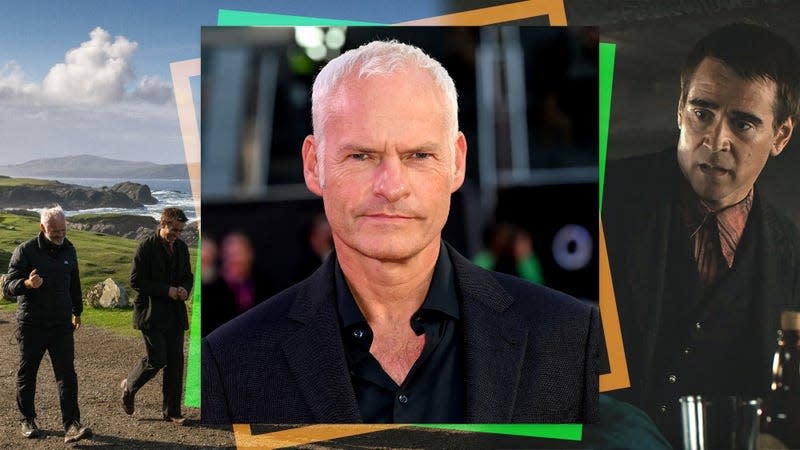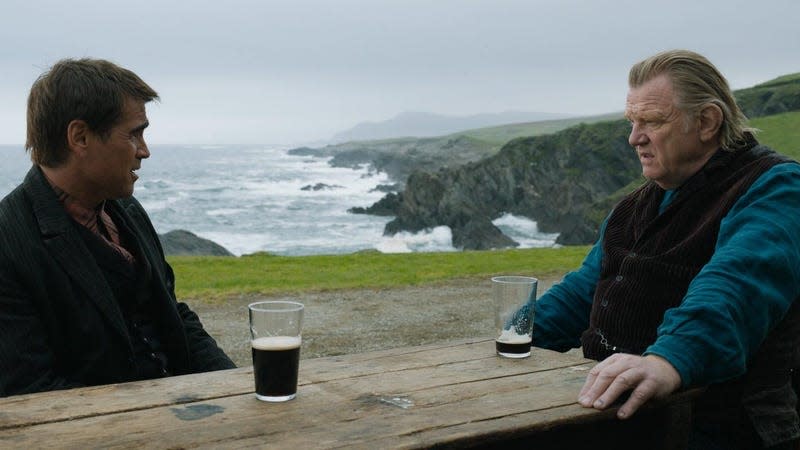How Martin McDonagh made a platonic breakup more devastating than any romantic split in The Banshees Of Inisherin

- Oops!Something went wrong.Please try again later.
- Oops!Something went wrong.Please try again later.
- Oops!Something went wrong.Please try again later.
- Oops!Something went wrong.Please try again later.
(Center) Martin McDonagh (Dominik Bindl/WireImage); (left and right) The Banshees Of Inisherin (Courtesy of Searchlight Pictures)
Cinematic synergy between filmmaker and muse abounds, but there may be no better combination of a director and two actors than Martin McDonagh and Colin Farrell and Brendan Gleeson. The co-stars channeled McDonagh’s trademark dark humor back in 2008 for In Bruges, and they do it again on a windswept, farm animal-filled Irish island in The Banshees Of Inisherin, co-starring Kerry Condon and Barry Keoghan. Farrell plays Pádraic, a simple man who is devastated to learn that Gleeson’s Colm, his best friend, is suddenly refusing to frequent the local pub with him on account of his being, well, “dull.” As McDonagh tells The A.V. Club, that initial revelation is the first of many that required the finest of fine-tuning for the dynamics between these two characters.
An Academy Award winner for the short film Six Shooter and a nominee for Three Billboards Outside Ebbing, Missouri (and partner to fellow British playwright-turned-screenwriter Phoebe Waller-Bridge), McDonagh excels at both conceiving and executing such dynamics. As he points out, platonic breakups aren’t often deemed worthy of an entire film’s plot; while The Banshees Of Inisherin might feel slight or silly at first glance, there’s an all-too-relatable world of hurt to explore. Read on for a peek behind McDonagh’s tragicomic curtain.
Read more
As <em>Halloween Ends</em>, let's rank the best performances of Jamie Lee Curtis
The 20 biggest game-changing moments from <em>The Walking Dead</em>
The A.V. Club: Colin Farrell and Brendan Gleeson create magic throughout The Banshees Of Inisherin, much like they did with In Bruges. How much was their casting integral to your writing process?
Martin McDonagh: One hundred percent. It was written for them. We always wanted to get back together in the last 14 years and remain friends and we’d see each other every year. And it was a hope but, you know, it was never going to come to fruition until I stopped being lazy and sat down and got on with it. And I tried a version maybe seven years ago which didn’t quite work, but the first five pages was just the break up part. And I went back to it, reread it, kept those five pages, but went to a completely different place for this screenplay. I threw away all the plot, basically, of the previous, and just let the sort of sadness of the breakup be what the film was about.
AVC: And what surprised you about working with these two actors again, on a scale between “like no time has passed” versus “starting from scratch?”
MM: It was very much the former, yeah. I felt like no time had passed and we just slipped into it. We had a couple of weeks of rehearsal, similar to what we had for In Bruges actually, and just slipped into it. Just back to being friends, going for dinners, discussing the scenes and the characters. There was an ease to it. Even the first day of filming, it was just like old friends hanging out really. And I think that kind of shows in the movie.
AVC: How important is the fact that these are two men going through this friend breakup? This film is set in the 1920s and coming out in 2022, and it struck me how little masculinity seems to have changed. Are men okay? I came away thinking men are not okay.
MM: I’d go along with that. [Laughs] Yeah, I think that’s probably true, sadly. But maybe if there’s more films like this, it will help. But I doubt it! Yeah, not speaking, not addressing one’s feelings, bearing grudges, all that stuff seems like it’s never going to go away. I try not to, but it’s still there in me too. I don’t know, I hope we are getting better as a species.
AVC: What fundamentally were you trying to unlock or understand about the friendship between these two characters?
MM: It was about painting a truthful picture of a breakup, really. A sad breakup, a platonic breakup, which can be as heavy and sad and destructive as a divorce, as a sexual or loving relationship coming to an end. Just to paint that sadness accurately was what I wanted to get over in the film.

AVC: And how consciously do you think about that specific idea being universal? Which I suppose is also a way of asking whether you think about appealing to a wide audience?
MM: I don’t ever try to appeal to a large number of people. But I do think we are sort of similar the world over. You certainly don’t want to alienate anyone. I think there is a universal—I mean, everyone’s really experienced a breakup, I think, from either side. Either they’ve dumped someone or been dumped. So I guess I knew that pain would be something that’s universal and understandable. But sad breakups by guys [laughs] isn’t really something you would think would sell tickets. And they might not, we’ll see what happens in a few weeks! But getting a film beautiful and sad and funny, you hope, will be something that everyone can get into.
AVC: It was fascinating to hear you talk about balancing the perspectives of Colin Farrell’s character, Pádraic, and Brendan Gleeson’s character, Colm, and how you shifted it from 60–40 in favor of Pádraic to 49–51. Could you talk about how you approached that? How important is it to make both characters in a breakup story relatable?
MM: I think rehearsals and talking to Brendan was a big help in just figuring out where [Colm’s] motives were. And his motives aren’t necessarily mean-spirited or evil or anything like that. He’s in the right, I guess. But when you’re trying to write a script or direct a film, I think you have to kind of be in everyone’s head and see that they’re all—everyone the world over probably thinks they’re in the right, but not all of us are. So it’s just to be truthful to that, to try and see the story for each of the characters’ perspectives. But Brendan’s especially. We talked about things like his opening gambit is very harsh and cruel, but it’s probably not how he wants to be. He knows that that is the way he has to be to get it through to Colin. You know, it’s about ripping the Band-Aid off in one, in the first scenes. Some of the problems arise from just trying to be nice after that fact, which opens up the gates for Colin’s character to think there’s hope. And there is no hope.
AVC: And there is no hope! The most heartbreaking moment for me is when Pádraic says “Oh, God,” realizing Colm is the one who hasn’t been worth spending time on.
MM: Oh, good, good. I love that moment. And it is the time when [Pádraic] questions who this guy was. You know, was he ever a decent man?
AVC: It’s always exciting to hear how speaking with actors changes a story. Was there anything that surprised you in either the scripting or the directing? It sounds like the rehearsals are where you had to keep honing this very precise relationship.
MM: Yeah. Also, often, I write a lot of pauses into a movie script. And I don’t think you’re supposed to! I think I missed that lesson in film school. [Laughs] But it’s often in the reactions to a line where the heart of a film is. It’s an obvious example, but when Colin Farrell hears “I just don’t like you no more,” there’s like 20 seconds of just reacting to that. And it’s just on his face. Now, you can’t write that. That’s the room for the actor to fill in the blanks. But I think the rehearsal process and the talking about it means we know that that room is there, that there will be space for that reaction.
AVC: One last, crucial question. What is the deal with all the animals? Are they supporting characters in this movie?
MM: I think they’re lead characters. In my next one, it’s just going to be all animals. [Laughs] Then I won’t have to deal with movie stars anymore.
More from The A.V. Club
Sign up for The A.V. Club's Newsletter. For the latest news, Facebook, Twitter and Instagram.

